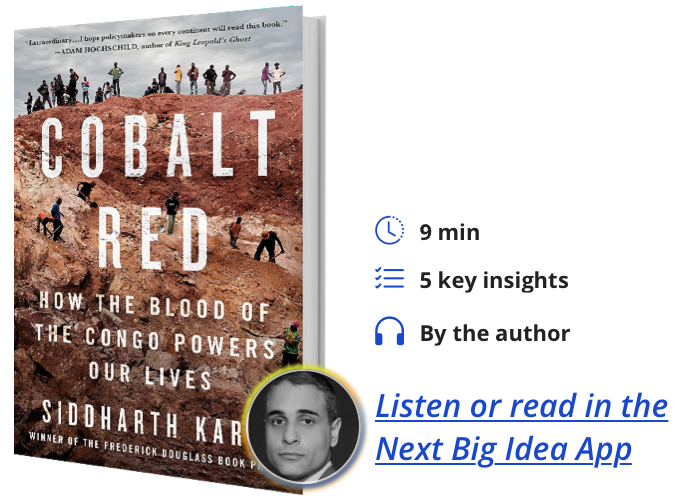Siddharth Kara is an author, researcher, and activist on modern slavery. He is a British Academy Global Professor and an Associate Professor of Human Trafficking and Modern Slavery at Nottingham University. Kara has authored three books on modern slavery and won the Frederick Douglass Book Prize. Kara’s first book was adapted into a Hollywood film, Trafficked. A feature film inspired by Cobalt Red is currently in pre-production.
Below, Siddharth shares 5 key insights from his new book, Cobalt Red: How the Blood of the Congo Powers Our Lives. Listen to the audio version—read by Siddharth himself—in the Next Big Idea App.

1. You cannot conduct your daily life without a mineral called cobalt.
Cobalt is a vital component to almost every lithium-ion rechargeable battery made today. That means cobalt is used in almost every smartphone, tablet, laptop, and electric vehicle that is used by billions of people around the world. Cobalt allows the batteries in these devices and cars to hold maximum charge while retaining thermal stability. Without cobalt, we would all be plugging in our gadgets and cars much more often, and eventually, those batteries might catch on fire. Electric vehicles in particular are driving the future demand for cobalt, as the battery packs in each EV require up to ten kilograms of refined cobalt. As the world transitions from fossil fuels towards clean energy, demand for cobalt is expected to soar by more than 300 percent by 2030.
2. Almost 75 percent of the world’s supply of cobalt is mined in the Democratic Republic of the Congo.
By virtue of geographic fluke, the DRC holds more cobalt reserves than the rest of the planet combined. As demand for cobalt grows, the Congo’s share of world production is expected only to increase, unleashing a scramble to dig cobalt out of the ground as quickly as possible. The Congo’s cobalt mines are located in the southeastern corner of the country near the Zambian border in an area called the Central African Copper Belt. An old colonial mining town called Lubumbashi is the administrative head of the Congo’s mining operations. Chinese companies dominate mining production in the region, controlling fifteen of the nineteen major copper-cobalt mining concessions in the DRC. These concessions are enormous—some of them are as big as a European city. Most of the production is centered around a town called Kolwezi. Type in that name to Google Earth and Zoom in. You will see giant open-air pit mines swallowing the city. The level of environmental destruction is startling.
3. Cobalt mining in the Congo is a human rights and environmental catastrophe.
There are hundreds of thousands of people in the Congo who dig for cobalt by hand, with shovels, pickaxes, and rebar. They are called artisanal miners, although this quaint term belies the miserable conditions under which they toil. Artisanal miners are responsible for 30 percent or more of the Congo’s total cobalt production. These men, women, and children as young as six dig for cobalt in highly hazardous conditions, suffering toxic contamination from cobalt dust, injuries from pit wall collapses, and worst of all, they are buried alive in tunnel collapses. There are ten to fifteen thousand tunnels dug by hand in the region, some of them are up to sixty meters deep as artisanal miners delve for higher grade sources of cobalt so that they can try to earn more money. None of these tunnels have supports, and based on the many months I have spent on the ground in the Congo, I can assure you that one of these tunnels collapses every week, burying alive everyone inside, including children.
“As demand for cobalt grows, the Congo’s share of world production is expected only to increase, unleashing a scramble to dig cobalt out of the ground as quickly as possible.”
For their backbreaking and hazardous work, artisanal miners are paid just few dollars per day, as they feed crucial cobalt up the chain to tech and EV companies worth trillions. To make matters worse, industrial mines have clear-cut millions of trees and dumped toxic contaminants and heavy metals into the earth, air, and water across the Congo’s mining provinces…all so that we can transition to greener sources of energy—green for everyone but the people in the Congo.
4. Companies at the top of the chain perpetuate fictions about conditions at the bottom.
The companies that sell us our rechargeable gadgets and electric cars all claim to have zero tolerance policies on child labor. They claim that the human rights of all who work in their supply chains are protected, all the way down the mining level. They will even suggest that their particular supply chains do not contain cobalt mined by peasants and children, and that the mines their supply chains operate sustainably.
Nothing could be further from the truth.
“The fictions promulgated atop of the cobalt chain are dispelled one by one.”
In Cobalt Red, I take you on a journey deep into the cobalt provinces to uncover the truth about the appalling conditions of cobalt mining, as told through the voices of the Congolese people who live, work, and die mining our cobalt. You learn, for instance, that every ounce of cobalt scrounged out of the ground by artisanal miners is purchased by industrial mining companies and mixed with their production. You also learn that artisanal miners are encouraged to dig on almost every industrial mine in the Congo…and why not? It is a way of boosting production at virtually no expense.
The fictions promulgated atop of the cobalt chain are dispelled one by one.
5. History is repeating itself in the Heart of Darkness.
This is not the first time the Congo has been pillaged for its resources, and that, too, relating to automobiles. In 1885, a German man named Benz developed a car with an internal combustion engine and wooden wheels suitable for slow speeds. In 1888, a Scotsman named Dunlop invented rubber tires that could support higher speeds.
King Leopold of Belgium had just gotten his hands on the entire Congo region in 1885 as a personal colony, and it just so happened that the Congo had one of the largest rubber tree forests in the world. Leopold deployed a mercenary army that terrorized and tortured the native Congolese people to extract rubber in one of the most ruthless episodes of slavery in history. Joseph Conrad was in the Congo at the time, and what he saw inspired his excoriating meditation on the colonial desecration of Africa: Heart of Darkness.
Over a century later, we are in the midst of a new automobile revolution, the transition from gas-powered cars to electric vehicles to help meet climate sustainability goals following the Paris Accords. The Congo is once again sitting on a vital resource needed for this second automobile revolution, and once again the people and environment of the Congo are being plundered without mercy. It is the latest chapter in a long history of torment in the heart of darkness.
To listen to the audio version read by author Siddharth Kara, download the Next Big Idea App today:































